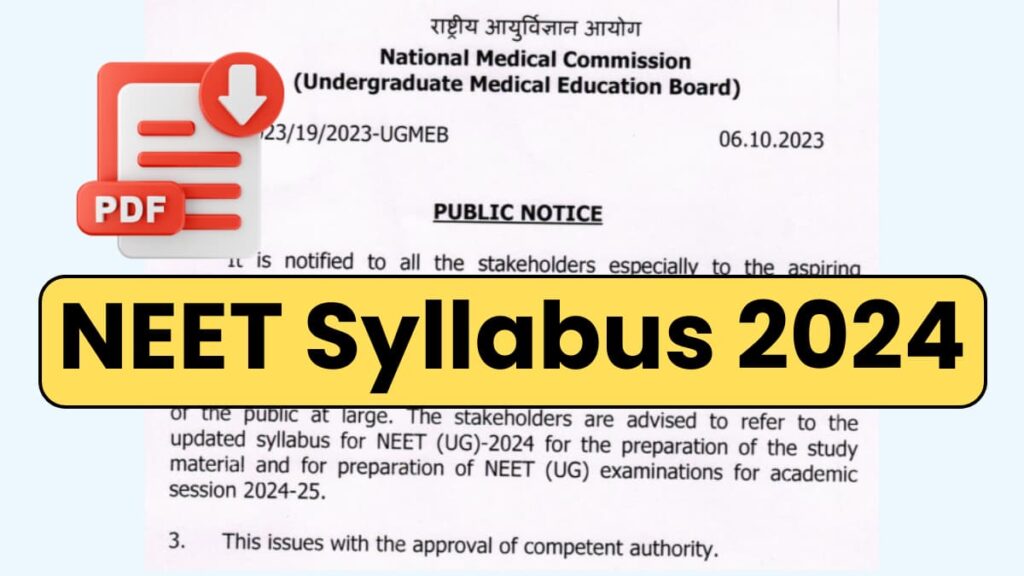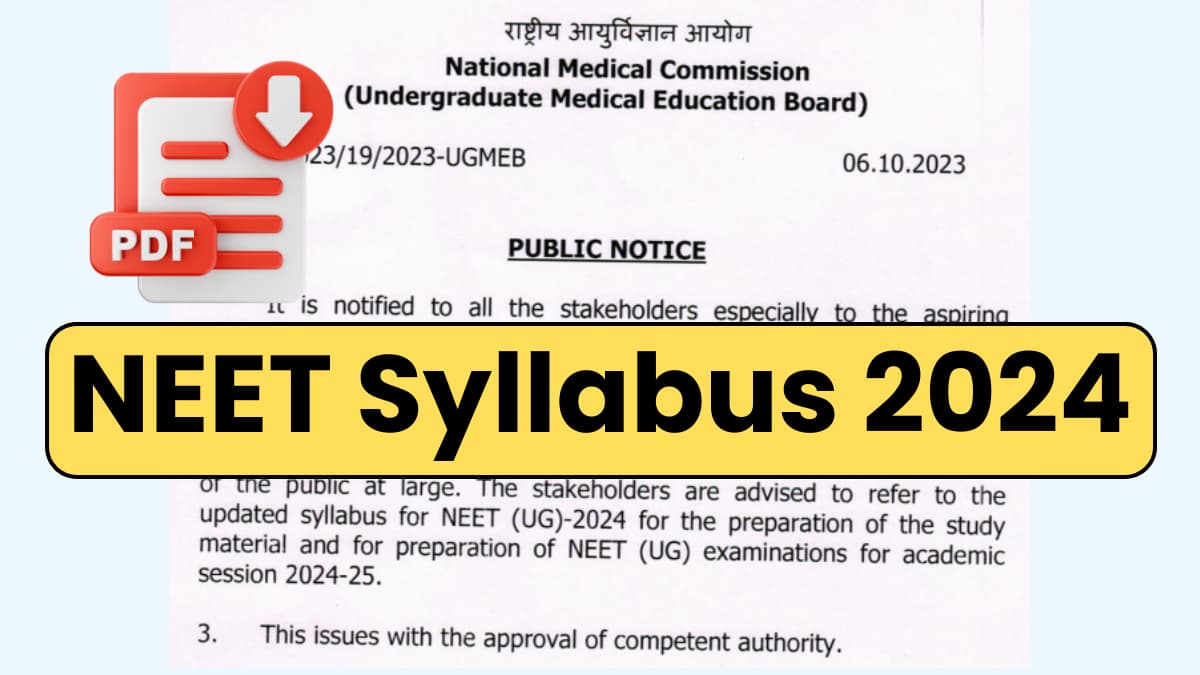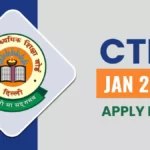The National Medical Commission (NMC) has released the NEET 2024 syllabus. The exam is scheduled to be conducted by the National Testing Agency (NTA) on May 5, 2024, across major cities in India and abroad. Till last year, NTA announced the NEET syllabus along with the information brochure and notification. This year, NMC has released the syllabus of NEET 2024, raising speculations regarding the reduction in the syllabus.
The NMC notice states, “It is notified to all the stakeholders, especially to the aspiring candidates that the Under Graduate Medical Education Board, an autonomous body under the National Medical Commission has finalised the NEET (UG) 2024 syllabus.
The same has been uploaded on NMC’s website for the reference of the public at large. The stakeholders are advised to refer to the updated syllabus for NEET (UG) 2024 for the preparation of the study material and for preparation of NEET (UG) examinations for the academic session 2024-25.”
After comparing the NEET 2024 syllabus with the previous year, it is seen that some chapters have been reduced in each of the three subjects, on the other hand, some of the units, or topics and chapters have been modified as well.
Click here to download the NEET 2024 syllabus released by NMC.

Changes Introduced in NEET 2024 Syllabus
Unlike last year, the syllabus is not segregated into Class 11 and Class 12 syllabus. On the other hand, the Chemistry syllabus is divided into Physical Chemistry, Organic Chemistry and Inorganic Chemistry. The following table brings the updated NEET syllabus 2024 for all three subjects, namely, Physics, Chemistry and Biology.
| Physics | Chemistry | Biology |
|---|---|---|
| Physics & Measurement | Physical Chemistry
Basic Concepts of Chemistry |
Diversity in Living World |
| Kinematics | Structure of Atom | Structural Organisation in Animals and Plants |
| Laws of Motion | Chemical Bonding and Molecular Structure | Cell Structure and Function |
| Work, Energy & Power | Chemical Thermodynamics | Plant Physiology |
| Rotational Motion | Solutions | Human Physiology |
| Gravitation | Equilibrium | Reproduction |
| Properties of Solids and Liquids | Redox Reactions and Electrochemistry | Genetics and Evolution |
| Thermodynamics | Chemical Kinetics | Biology and Human Welfare |
| Kinetic Theory of Gases | Inorganic Chemistry
Classification of Elements and Periodicity in Properties |
Biotechnology and Its Applications |
| Oscillations and Waves | p-Block Elements | Ecology and Environment
|
| Electrostatics | d- and f- Block Elements | |
| Current Electricity | Coordination Compounds | |
| Magnetic Effects of Current & Magnetism | Organic Chemistry
Purification and Characterisation of Organic Compounds |
|
| Electromagnetic Inductions & Alternating Currents | Some Basic Principles of Organic Chemistry | |
| Electromagnetic Waves | Hydrocarbons | |
| Optics | Organic Compounds Containing Halogens | |
| Dual Nature of Matter and Radiation | Organic Compounds Containing Oxygen | |
| Atoms and Nuclei | Organic Compounds Containing Nitrogen | |
| Electronic Devices | Biomolecules | |
| Experimental Skills | Principles Related to Practical Chemistry |
In Physics, one or more topics have been removed from the units of Physical World and Measurement, Kinematics, Motion, Properties of Bulk Matter, Current Electricity, etc. In Chemistry, topics of Environmental Chemistry, Chemistry in Everyday Life, Polymers, etc. In the Biology subject, topics from Plant Physiology, Human Physiology, Reproduction, Ecology and Environment, etc.
In terms of addition, units of Experimental Skills in Physics and Chemistry, Chemical Bonding and Molecular Structure, Purification and Characterisation of Chemical Compounds, etc. have been added.
List of Reduced Chapters in NEET 2024 Syllabus
Take a look at the list of chapters which have been removed from the NMC NEET syllabus 2024.
| Physics | Chemistry | Biology |
|---|---|---|
Unit I: Physical-world and Measurement
|
Unit I: Some Basic Concepts of ChemistryGeneral Introduction: Important and scope of chemistry. |
Unit II: Structural Organisation in Animals and PlantsAnimal tissues; Morphology, anatomy and functions of different systems (digestive, circulatory, respiratory, nervous and reproductive) of an insect (Frog). (Brief account only) |
Unit II: KinematicsElementary concepts of differentiation and integration for describing motion. Scalar and vector quantities: Position and displacement vectors, general vectors, general vectors and notation, equality of vectors, multiplication of vectors by a real number; addition and subtraction of vectors. Relative velocity. |
Unit II: Structure of AtomAtomic number, isotopes and isobars, Concept of shells and subshells, dual nature of matter and light. |
Unit IV: Plant Physiology
|
Unit III: Laws of MotionLubrication (under the Equilibrium of Concurrent Forces chapter) |
Unit XI: Some p-Block ElementsImportant compounds of silicon and a few uses: silicon tetrachloride, silicones, silicates and zeolites, their uses. |
Unit V: Human PhysiologyDigestion and absorption; Alimentary canal and digestive glands; Role of digestive enzymes and gastrointestinal hormones; Peristalsis, digestion, absorption and assimilation of proteins, carbohydrates and fats; Caloric value of proteins, carbohydrates and fats; Egestion; Nutritional and digestive disorders – PEM, indigestion, constipation, vomiting, jaundice, diarrhoea. |
| Unit V: Rotational Motion
Momentum conservation, and centre of mass motion. |
UNIT XIII: Organic Compounds Containing NitrogenCyanides and Isocyanides- will be mentioned at relevant places. |
Unit I: ReproductionReproduction in organisms: Reproduction, a characteristic feature of all organisms for continuation of species; Modes of reproduction – Asexual and sexual; Asexual reproduction; Modes-Binary fission, sporulation, budding, gemmule, fragmentation; vegetative propagation in plants. |
Unit VI: GravitationGeostationary satellites. |
UNIT XIV: Environmental ChemistryEnvironmental pollution: Air, water and soil pollution, chemical reactions in atmosphere, smogs, major atmospheric pollutants; acid rain ozone and its reactions, effects of depletion of ozone layer, greenhouse effect and global warming-pollution due to industrial wastes; green chemistry as an alternative tool for reducing pollution, strategy for control of environmental pollution. |
Unit III: Biology and Human WelfareImprovement in food production; Plant breeding, tissue culture, single cell protein, Biofortification; Apiculture and Animal husbandry. |
Unit VII: Properties of Bulk Matter/Properties of Solids and Liquids
|
UNIT XV: PolymersClassification- Natural and synthetic, methods of polymerization (addition and condensation), copolymerization. Some important polymers: natural and synthetic like polyesters, bakelite; rubber, Biodegradable and non-biodegradable polymers. |
Unit V: Ecology and EnvironmentOrganisms and environment: Habitat and niche; Population and ecological adaptations Ecosystem Patterns: Nutrient cycling (carbon and phosphorous); Ecological succession; Ecological Services fixation, pollination, oxygen release. Biodiversity and its conservation: Sacred Groves. Environmental issues: Air pollution and its control; Water pollution and its control; Agrochemicals and their effects; Solid waste management; Radioactive waste management; Greenhouse effect and global warning; Ozone depletion; Deforestation; Any three case studies as success stories addressing environmental issues. |
Unit VIII: ThermodynamicsHeat engines and refrigerators. |
UNIT XVI: Chemistry in Everyday Life• Chemicals in medicines- analgesics, tranquilizers, antiseptics, disinfectants, antimicrobials, antifertility drugs, antibiotics, antacids, antihistamines. |
|
Unit X: Oscillations and Waves
|
Unit V: Surface ChemistryAdsorption-physisorption and chemisorption; factors affecting adsorption of gases on solids, |
|
Unit I: ElectrostaticsVan de Graaff generator. |
Unit X: Haloalkanes and Haloarenes
|
|
Unit II: Current ElectricityThe flow of electric charges in a metallic conductor, Carbon resistors, colour code for carbon resistors; Potentiometer-principle and applications to measure potential difference, and for comparing emf of two cells; measurement of internal resistance of a cell. |
||
| Unit III: Magnetic Effects of Current and Magnetism
Concept of magnetic field, Oersted’s experiment. Magnetic dipole moment of a revolving electron. bar magnet as an equivalent solenoid, magnetic field lines; Earth’s magnetic field and magnetic elements. Electromagnetic and factors affecting their strengths. Permanent magnets. |
||
Unit IV: Electromagnetic Induction and Alternating CurrentsLC oscillations (qualitative treatment only) |
||
Unit VI: Optics
|
||
Unit VII: Dual Nature of Matter and RadiationDavisson-Germer experiment (experimental details should be omitted; only conclusion should be explained). |
||
Unit VIII: Atoms and NucleiIsotopes, isobars; isotones. Radioactivity- alpha, beta and gamma particles/ rays and their properties decay law. |
||
Unit IX: Electronic DevicesEnergy bands in solids (qualitative ideas only), conductors, insulators, Junction transistor, transistor action, characteristics of a transistor; transistor as an amplifier (common emitter configuration) and oscillator. |
NEET 2024 Important Dates
Except for the NEET 2024 exam date, no other schedule has been announced yet. The following table brings the NEET 2024 important dates, for the announced date, as well as tentative ones.
| Events | Dates (Tentative) |
|---|---|
| NEET 2024 exam date announcement | September 19, 2023 |
| NEET 2024 registration process | First week of March 2024 to First week of April 2024 |
| NEET 2024 application correction process | Second week of April 2024 |
| NEET 2024 admit card | First week of May 2024 |
| NEET 2024 exam date | May 5, 2024 |
| NEET 2024 answer key release | First week of June 2024 |
| NEET 2024 result and final answer key | Second week of June 2024 |
As per the above table, the subject in which the highest number of chapters reduced by NMC from the NEET syllabus is Physics, followed by Chemistry and Biology.
NEET is the biggest and only entrance exam for admission to medical and allied courses such as MBBS, BDS, BSc Nursing, BAMS, BUMS, BHMS, BSMS, BVSc & AH, among others. Over 20 lakh candidates are expected to appear for the exam. The NEET 2024 application form is expected to be released in the first week of March 2024 along with the notification and information brochure.








